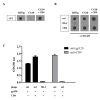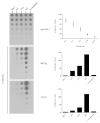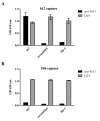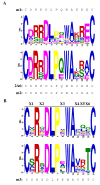Allosteric induction of the CD4-bound conformation of HIV-1 Gp120
- PMID: 24304511
- PMCID: PMC4235218
- DOI: 10.1186/1742-4690-10-147
Allosteric induction of the CD4-bound conformation of HIV-1 Gp120
Abstract
Background: HIV-1 infection of target cells is mediated via the binding of the viral envelope protein, gp120, to the cell surface receptor CD4. This interaction leads to conformational rearrangements in gp120 forming or revealing CD4 induced (CD4i) epitopes which are critical for the subsequent recognition of the co-receptor required for viral entry. The CD4-bound state of gp120 has been considered a potential immunogen for HIV-1 vaccine development. Here we report on an alternative means to induce gp120 into the CD4i conformation.
Results: Combinatorial phage display peptide libraries were screened against HIV-1 gp120 and short (14aa) peptides were selected that bind the viral envelope and allosterically induce the CD4i conformation. The lead peptide was subsequently systematically optimized for higher affinity as well as more efficient inductive activity. The peptide:gp120 complex was scrutinized with a panel of neutralizing anti-gp120 monoclonal antibodies and CD4 itself, illustrating that peptide binding does not interfere with or obscure the CD4 binding site.
Conclusions: Two surfaces of gp120 are considered targets for the development of cross neutralizing antibodies against HIV-1; the CD4 binding site and CD4i epitopes. By implementing novel peptides that allosterically induce the CD4i epitopes we have generated a viral envelope that presents both of these surfaces simultaneously.
Figures









Similar articles
-
Range of CD4-Bound Conformations of HIV-1 gp120, as Defined Using Conditional CD4-Induced Antibodies.J Virol. 2016 Apr 14;90(9):4481-4493. doi: 10.1128/JVI.03206-15. Print 2016 May. J Virol. 2016. PMID: 26889042 Free PMC article.
-
Characterization of CD4-induced epitopes on the HIV type 1 gp120 envelope glycoprotein recognized by neutralizing human monoclonal antibodies.AIDS Res Hum Retroviruses. 2002 Nov 1;18(16):1207-17. doi: 10.1089/08892220260387959. AIDS Res Hum Retroviruses. 2002. PMID: 12487827
-
Unique binding modes for the broad neutralizing activity of single-chain variable fragments (scFv) targeting CD4-induced epitopes.Retrovirology. 2017 Sep 22;14(1):44. doi: 10.1186/s12977-017-0369-y. Retrovirology. 2017. PMID: 28938888 Free PMC article.
-
Structure-based design, synthesis and validation of CD4-mimetic small molecule inhibitors of HIV-1 entry: conversion of a viral entry agonist to an antagonist.Acc Chem Res. 2014 Apr 15;47(4):1228-37. doi: 10.1021/ar4002735. Epub 2014 Feb 6. Acc Chem Res. 2014. PMID: 24502450 Free PMC article. Review.
-
The Genesis and Future Prospects of Small Molecule HIV-1 Attachment Inhibitors.Adv Exp Med Biol. 2022;1366:45-64. doi: 10.1007/978-981-16-8702-0_4. Adv Exp Med Biol. 2022. PMID: 35412134 Review.
Cited by
-
Range of CD4-Bound Conformations of HIV-1 gp120, as Defined Using Conditional CD4-Induced Antibodies.J Virol. 2016 Apr 14;90(9):4481-4493. doi: 10.1128/JVI.03206-15. Print 2016 May. J Virol. 2016. PMID: 26889042 Free PMC article.
-
Antibody Recognition of CD4-Induced Open HIV-1 Env Trimers.J Virol. 2022 Dec 21;96(24):e0108222. doi: 10.1128/jvi.01082-22. Epub 2022 Nov 30. J Virol. 2022. PMID: 36448805 Free PMC article.
References
Publication types
MeSH terms
Substances
LinkOut - more resources
Full Text Sources
Other Literature Sources
Research Materials

